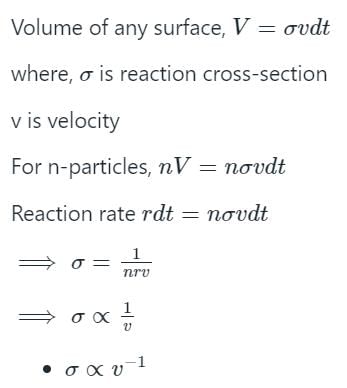EmSAT Achieve Exam > EmSAT Achieve Questions > A thermal neutron having speed v impinges on ...
Start Learning for Free
A thermal neutron having speed v impinges on a 235⋃ nucleus. The reaction cross-section is proportional to
- a)v-1
- b)v
- c)√v
- d)v-1/2
Correct answer is option 'A'. Can you explain this answer?
Verified Answer
A thermal neutron having speed v impinges on a235 nucleus. The reactio...

Most Upvoted Answer
A thermal neutron having speed v impinges on a235 nucleus. The reactio...
Understanding Neutron Interaction with Nuclei
When a thermal neutron collides with a nucleus, such as U-235, the likelihood of a reaction occurring is described by the reaction cross-section. This cross-section is influenced by various factors, one of which is the speed of the neutron.
Reaction Cross-Section and Speed
- The reaction cross-section (\( \sigma \)) can be thought of as an effective target area that quantifies the probability of a neutron interacting with a nucleus.
- As the speed (\( v \)) of the neutron increases, the rate at which it encounters the target nucleus also increases.
Dependence on Speed
The relationship between reaction cross-section and neutron speed can be derived from the kinetic theory of gases and the principles of nuclear physics.
- Proportionality to \( v^{-1} \): The reaction cross-section is inversely proportional to the speed of the neutron. This means that as the speed increases, the effective area for interaction decreases.
- Mathematically, this can be represented as:
\[
\sigma \propto \frac{1}{v}
\]
- This relationship arises because faster neutrons have shorter interaction times with the nucleus, reducing the chance of a successful reaction.
Conclusion
Thus, the correct answer to the question of how the reaction cross-section is proportional to the speed of a thermal neutron impinging on a U-235 nucleus is option A: \( v^{-1} \). Understanding this relationship is crucial in nuclear physics and applications like nuclear reactors and radiation shielding.
When a thermal neutron collides with a nucleus, such as U-235, the likelihood of a reaction occurring is described by the reaction cross-section. This cross-section is influenced by various factors, one of which is the speed of the neutron.
Reaction Cross-Section and Speed
- The reaction cross-section (\( \sigma \)) can be thought of as an effective target area that quantifies the probability of a neutron interacting with a nucleus.
- As the speed (\( v \)) of the neutron increases, the rate at which it encounters the target nucleus also increases.
Dependence on Speed
The relationship between reaction cross-section and neutron speed can be derived from the kinetic theory of gases and the principles of nuclear physics.
- Proportionality to \( v^{-1} \): The reaction cross-section is inversely proportional to the speed of the neutron. This means that as the speed increases, the effective area for interaction decreases.
- Mathematically, this can be represented as:
\[
\sigma \propto \frac{1}{v}
\]
- This relationship arises because faster neutrons have shorter interaction times with the nucleus, reducing the chance of a successful reaction.
Conclusion
Thus, the correct answer to the question of how the reaction cross-section is proportional to the speed of a thermal neutron impinging on a U-235 nucleus is option A: \( v^{-1} \). Understanding this relationship is crucial in nuclear physics and applications like nuclear reactors and radiation shielding.

|
Explore Courses for EmSAT Achieve exam
|

|
A thermal neutron having speed v impinges on a235 nucleus. The reaction cross-section is proportional toa)v-1b)vc)√vd)v-1/2Correct answer is option 'A'. Can you explain this answer?
Question Description
A thermal neutron having speed v impinges on a235 nucleus. The reaction cross-section is proportional toa)v-1b)vc)√vd)v-1/2Correct answer is option 'A'. Can you explain this answer? for EmSAT Achieve 2025 is part of EmSAT Achieve preparation. The Question and answers have been prepared according to the EmSAT Achieve exam syllabus. Information about A thermal neutron having speed v impinges on a235 nucleus. The reaction cross-section is proportional toa)v-1b)vc)√vd)v-1/2Correct answer is option 'A'. Can you explain this answer? covers all topics & solutions for EmSAT Achieve 2025 Exam. Find important definitions, questions, meanings, examples, exercises and tests below for A thermal neutron having speed v impinges on a235 nucleus. The reaction cross-section is proportional toa)v-1b)vc)√vd)v-1/2Correct answer is option 'A'. Can you explain this answer?.
A thermal neutron having speed v impinges on a235 nucleus. The reaction cross-section is proportional toa)v-1b)vc)√vd)v-1/2Correct answer is option 'A'. Can you explain this answer? for EmSAT Achieve 2025 is part of EmSAT Achieve preparation. The Question and answers have been prepared according to the EmSAT Achieve exam syllabus. Information about A thermal neutron having speed v impinges on a235 nucleus. The reaction cross-section is proportional toa)v-1b)vc)√vd)v-1/2Correct answer is option 'A'. Can you explain this answer? covers all topics & solutions for EmSAT Achieve 2025 Exam. Find important definitions, questions, meanings, examples, exercises and tests below for A thermal neutron having speed v impinges on a235 nucleus. The reaction cross-section is proportional toa)v-1b)vc)√vd)v-1/2Correct answer is option 'A'. Can you explain this answer?.
Solutions for A thermal neutron having speed v impinges on a235 nucleus. The reaction cross-section is proportional toa)v-1b)vc)√vd)v-1/2Correct answer is option 'A'. Can you explain this answer? in English & in Hindi are available as part of our courses for EmSAT Achieve.
Download more important topics, notes, lectures and mock test series for EmSAT Achieve Exam by signing up for free.
Here you can find the meaning of A thermal neutron having speed v impinges on a235 nucleus. The reaction cross-section is proportional toa)v-1b)vc)√vd)v-1/2Correct answer is option 'A'. Can you explain this answer? defined & explained in the simplest way possible. Besides giving the explanation of
A thermal neutron having speed v impinges on a235 nucleus. The reaction cross-section is proportional toa)v-1b)vc)√vd)v-1/2Correct answer is option 'A'. Can you explain this answer?, a detailed solution for A thermal neutron having speed v impinges on a235 nucleus. The reaction cross-section is proportional toa)v-1b)vc)√vd)v-1/2Correct answer is option 'A'. Can you explain this answer? has been provided alongside types of A thermal neutron having speed v impinges on a235 nucleus. The reaction cross-section is proportional toa)v-1b)vc)√vd)v-1/2Correct answer is option 'A'. Can you explain this answer? theory, EduRev gives you an
ample number of questions to practice A thermal neutron having speed v impinges on a235 nucleus. The reaction cross-section is proportional toa)v-1b)vc)√vd)v-1/2Correct answer is option 'A'. Can you explain this answer? tests, examples and also practice EmSAT Achieve tests.

|
Explore Courses for EmSAT Achieve exam
|

|
Signup for Free!
Signup to see your scores go up within 7 days! Learn & Practice with 1000+ FREE Notes, Videos & Tests.
























